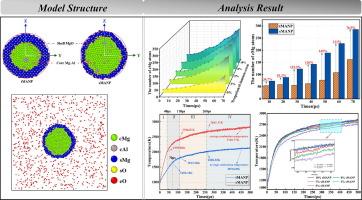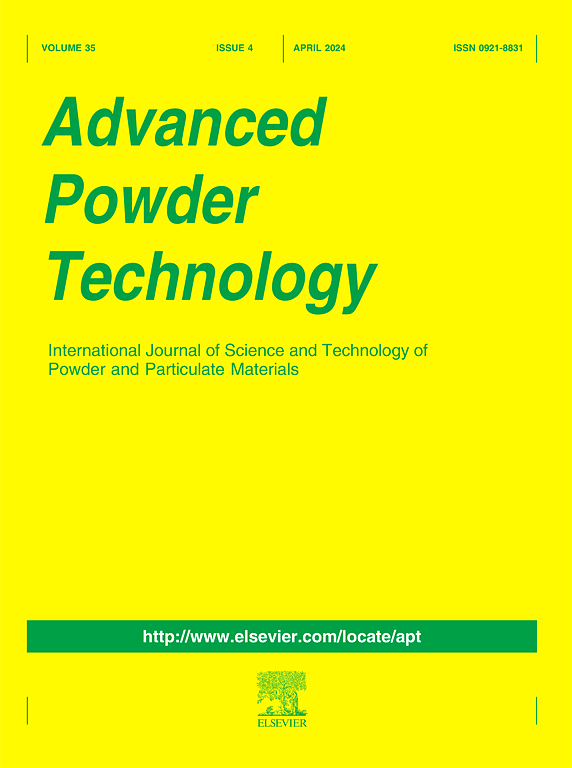通过TG-DSC和ReaxFF MD模拟Mg-Al合金的点火和燃烧机理
IF 4.2
2区 工程技术
Q2 ENGINEERING, CHEMICAL
引用次数: 0
摘要
镁铝合金是固体推进剂中常用的高能粉末材料。阐明它们的点火和燃烧机理对于指导合金成分和颗粒结构设计,从而提高固体推进剂的燃烧性能至关重要。本研究利用TG-DSC热分析和ReaxFF分子动力学模拟研究了Al含量和氧化程度对Mg-Al纳米颗粒(MANP)在点火和燃烧过程中的化学键合、扩散行为以及热力学和结构性能的影响。核心Mg原子与外部氧原子的相互扩散是加速MANP着火燃烧的关键。在加热过程中,Al原子的局域聚类增强了Mg原子的向外扩散,导致核心区原子更早熔化,加速了MANP的点火。这与TG-DSC实验结果一致,表明Al的加入降低了加速氧化阶段的起始温度。MANP燃烧可分为快速上升、缓慢和稳定三个阶段。氧化层越薄的MANP,其核心mg原子的扩散强度越强,颗粒表面对氧的吸附能力也越强,升温速率和峰值温度也越高。本文章由计算机程序翻译,如有差异,请以英文原文为准。

Ignition and combustion mechanisms in Mg-Al alloys via TG-DSC and ReaxFF MD simulations
Magnesium-aluminum (Mg-Al) alloys are commonly used as high-energy powder materials in solid propellants. Clarifying their ignition and combustion mechanisms is essential to guide alloy composition and particle structure design, thereby improving solid propellant combustion performance. This study utilizes TG-DSC thermal analysis and ReaxFF molecular dynamics simulations to investigate the effect of Al content and oxidation degree on chemical bonding, diffusion behavior, as well as the thermodynamic and structural properties of Mg-Al nanoparticle (MANP) in ignition and combustion. Mutual diffusion of core Mg and external oxygen atoms is critical for accelerating the ignition and combustion of MANP. During heating, the localized clustering of Al atoms enhances the outward diffusion of Mg atoms, resulting in earlier melting of core-region atoms and facilitating faster ignition of MANP. This is consistent with TG-DSC experimental results showing that the addition of Al lowers the onset temperature of the accelerated oxidation stage. MANP combustion can be divided in three stages: rapid rise, slow and stable stage. MANP with thinner oxide layers exhibit stronger diffusion intensity of core-Mg atoms and a significantly higher capacity for oxygen adsorption on the particle surface, resulting in a higher temperature rise rate and peak temperature.
求助全文
通过发布文献求助,成功后即可免费获取论文全文。
去求助
来源期刊

Advanced Powder Technology
工程技术-工程:化工
CiteScore
9.50
自引率
7.70%
发文量
424
审稿时长
55 days
期刊介绍:
The aim of Advanced Powder Technology is to meet the demand for an international journal that integrates all aspects of science and technology research on powder and particulate materials. The journal fulfills this purpose by publishing original research papers, rapid communications, reviews, and translated articles by prominent researchers worldwide.
The editorial work of Advanced Powder Technology, which was founded as the International Journal of the Society of Powder Technology, Japan, is now shared by distinguished board members, who operate in a unique framework designed to respond to the increasing global demand for articles on not only powder and particles, but also on various materials produced from them.
Advanced Powder Technology covers various areas, but a discussion of powder and particles is required in articles. Topics include: Production of powder and particulate materials in gases and liquids(nanoparticles, fine ceramics, pharmaceuticals, novel functional materials, etc.); Aerosol and colloidal processing; Powder and particle characterization; Dynamics and phenomena; Calculation and simulation (CFD, DEM, Monte Carlo method, population balance, etc.); Measurement and control of powder processes; Particle modification; Comminution; Powder handling and operations (storage, transport, granulation, separation, fluidization, etc.)
 求助内容:
求助内容: 应助结果提醒方式:
应助结果提醒方式:


